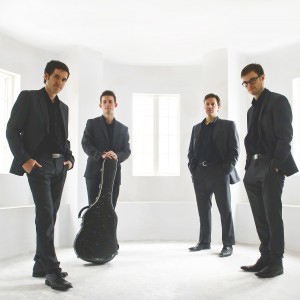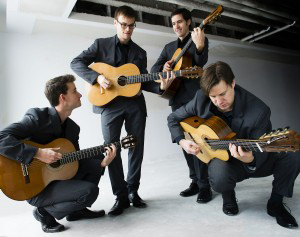The Canadian Guitar Quartet
Julien Bisaillon – Renaud Côté-Giguère – Bruno Roussel – Louis Trépanier
Tuesday, January 24, 2017 | 7:30 PM | James Hall
Admission $22 - Students 18 & under free with student ticket voucher
Tickets are available:
| • at the
Academy Box Office – 7280 Kemano Street, Monday – Thursday 9:30 - 4:30 • by phone at 604 485 9633 • and at the door 30 minutes before the concert |

Since its debut in 1999, the Canadian Guitar Quartet has toured extensively in North and South America, from one standing ovation to the next, establishing a reputation as one of the finest guitar ensembles in the world. The CGQ has appeared with orchestra across Canada, and has recorded three critically acclaimed CDs.
The quartet has been broadcast on both CBC and Radio-Canada, has had a special performance feature on Bravo! Television, was featured in the webcast at Chicago’s Northwestern University, on CBC’s overseas networks, and in various international magazines. The CGQ’s first concert at the 92Street Y in New York, part of the Art of the Guitar series, was extremely well received. Don Witter Jr., of the New York Classical Guitar Society, wrote: “The Canadian Guitar Quartet made one of the greatest New York City Debuts of any artistic ensemble in decades … STUNNING !!!”.
 Concerts in some of Canada’s most prestigious concert halls, such as the Winspear Center, the Palais Montcalm, the Glenn Gould Studio, and National Gallery of Canada, as well as their performances in seminal events such as the Guitar Foundation of America’s annual convention, Yale’s Guitar Extravaganza, the Norfolk and Ottawa chamber music festivals, have allowed the Canadian Guitar Quartet to develop an international reputation. The mix of dynamic original music and classical masterpieces make a CGQ concert an unforgettable experience.
Concerts in some of Canada’s most prestigious concert halls, such as the Winspear Center, the Palais Montcalm, the Glenn Gould Studio, and National Gallery of Canada, as well as their performances in seminal events such as the Guitar Foundation of America’s annual convention, Yale’s Guitar Extravaganza, the Norfolk and Ottawa chamber music festivals, have allowed the Canadian Guitar Quartet to develop an international reputation. The mix of dynamic original music and classical masterpieces make a CGQ concert an unforgettable experience.
For more information, listen at their YouTube channel or visit canadianguitarquartet.com.
P R O G R A M
| Concerto RV.531 I-Allegro II-Largo III-Allegro |
Antonio Vivaldi (1678-1741) arr. Bruno Roussel |
| Octopus | Hans Brüderl (1959 - ) |
| Fille de Cuivre I-Enveloppe Isolante II-Sans Alliage III-Touret |
Renaud Côté-Giguère (1990 - ) |
| String Quartet Op. 59, No. 3 Menuetto. Grazioso – Trio Allegro Molto |
Ludwig van Beethoven (1770-1827) arr. Denis Donegani |
| Intermission | |
| Danse Macabre | Camille Saint-Saëns (1835-1921) arr. Louis Trépanier |
| Hungarian Dances, Nos. 1, 4, 5 | Johannes Brahms (1833-1897) arr. Denis Donegani / Louis Trépanier |
| En las Calles de Buenos Aires | Patrick Roux (1962 - ) |
| William Tell Overture | Gioachino Rossini (1792-1868) arr. Bruno Roussel |
Program notes:
Concerto R.V. 531, by Antonio Vivaldi. Vivaldi’s only concerto for two celli and orchestra follows the traditional fast-slow-fast, three-movement model. The two soloists are given imitating lines that call, answer, and sometimes combine. In Bruno Roussel’s arrangement, the roles of soloists, orchestra, and continuo (accompaniment instruments) are shared between the guitarists. In the first movement Julien and Bruno act as soloists, but do have bits that belong to the background too. In the second movement, it’s Renaud and Louis’ turn to share the solo lines. Finally, in the last movement, it’s all hands on deck as the players acrobatically exchange roles.
Octopus, by Hans Brüderl. German guitarist and composer Hans Brüderl wrote Octopus for the G8 project, a collaboration between the Canadian Guitar Quartet and Brüderl’s Salzburger Guitarrenquartet. This happy work of music employs some jazzy sounds, a Turkish melody, pop harmonies, and bouncy rhythms throughout its various episodes. The work was so enjoyed by the CGQ players that Louis Trépanier adapted it to be played on four guitars. The title is a play on words: Oct-Opus, work for eight.
Fille de cuivre, by Renaud Côté-Giguère. Fille de Cuivre (“Copper Girl”) was inspired by the art of Jean-Louis Émond, a famous québecois sculptor who works with small pieces of metal that he welds together to form life-size human sculptures. One of his works is a girl made of copper in which he purposely left the back of the sculpture open, so we can see all the rough and unrefined welds from one side and the beautiful and perfectly polished lady on the other. This was meant to show how someone can be fragile and broken from the inside, but appear beautiful and solid on the surface. Renaud Côté-Giguère then imagined this copper girl’s life, and to him it depicted a bristle of emotions that result from being far from family members and friends. The movements’ titles therefore refer to elements of the copper wires used in our communications systems. It would be only through these systems that the girl and her loved ones have contact.
1. Enveloppe Isolante, the insulated wire sleeve keeping the connections together;
2. Sans Alliage, the lack of alloy in the copper and
3. Touret, the big cable spools on which the copper wires are wound.
There is also a play on word in the French title, since fille (girl) and fil (wire) are close in pronunciation. This copper girl also represents our modern days communication system, wherein more and more people fall in love with their computers.
String Quartet, Op. 59, No. 3, by Ludwig Van Beethoven. This string quartet is part of the “Razumovsky quartets”, named for one of Beethoven’s patrons, the Count Razumovsky, the Russian ambassador to Vienna. These famous quartets are prime examples of the composer’s middle period. The last two movements of the Op. 59 No. 3 were arranged for guitar quartet by former CGQ member Denis Donegani. The third movement, a minuet and trio, shows Beethoven at his elegant best; while fourth movement’s fugal architecture is equaled, perhaps even surpassed by its sheer exuberance. Danse Macabre, by Camille Saint-Saëns. The original version of this work was a song for solo voice and piano accompaniment, setting the poem, Danse Macabre (by French poet Henri Casalis) to music. The poem relates a cold dark night in which Death calls souls out of their resting places to partake in lascivious antics throughout the night; their bacchanalia is eventually interrupted by the crowing of the rooster and the arrival of the dawn – the last notes of the piece depict the last coffins banging shut. The song’s lack of success on the concert stage prompted Saint-Saëns to rework it into an orchestra piece, thus creating the genre known as the symphonic poem. In Louis Trépanier’s arrangement, various effects are required to recreate orchestral soundscapes on guitars, including strumming the strings above the headstock nut; this imitates the plink of the xylophone, used for the first time in symphonic music in the Danse Macabre.
Hungarian Dances, by Johannes Brahms. Brahms’ set of 21 Hungarian Dances remain among his popular works. Most are based on traditional Hungarian melodies, and mix the composer’s sense of form and romantic harmony with the exotic sounds of the source materials. The original version was for piano four hands, and translate quite easily to guitar quartet, where for the most part each player covers one pianist’s hand. These transcriptions, by Denis Donegani and Louis Trépanier, were the very first new material transcribed by a fledgling Canadian Guitar Quartet back in 1999.
Concierto Tradicionuevo, by Patrick Roux. This large scale work in two movements pays homage to the tango of Argentina: first, a nod to the great Carlos Gardel (1890-1935), singer and composer, the most important protagonist in the story of the tango. A visit to Cafe Gardel, an actual establishment in Buenos Aires, escorts the listener through various rooms in which tangos of differing moods and characters succeed one another, all in the colours of the more traditional tango. In the second movement, En las Calles de Buenos Aires, the modernized tango-style of Astor Piazzolla (1921-1992) becomes the sound track to a wild taxi ride through the streets of the Argentine metropolis, rich in energetic urban sounds and textures; a gentle, middle section offers a glimpse of what calm might exist among the hustle and bustle when the cab eventually stops at a light. The composer’s sad recollection of a young street urchin, seemingly the same age as one his own daughters, as she pressed into his taxi window inform the melancholy of the section…but, then, the light turns green and we are hurled forward into the streets of Buenos Aires.
The William Tell Overture, by Gioacchino Rossini. The tale of William Tell is quite famous – for having defied the Austrian governor, Swiss patriot Tell must shoot an apple from his son’s head with his crossbow. Rossini’s opera weaves a dramatic tale of love and uprising amid the splendor of the Swiss Alps. The overture has come to much greater fame than the full opera, as the closing fanfare of the overture became the theme for the adventures of the Lone Ranger. The full overture is in four parts, each having been used in movies, cartoons, and commercials. Bruno Roussel’s arrangement requires the players to pull out all the stops to recreate the lush sounds of a full orchestra. Again, the CGQ’s trademark acrobatic juggling of different parts of the music is highlighted. The overture’s four episodes depict first, an opening and dawning of the day in the Alps; then a storm occurs over Lake Geneva; the very famous third part imitates the calls of the Alphorns among the shepherds; the ‘Lone Ranger’ theme, the fourth section was actually meant to symbolize the muster of the Swiss liberation armies.







